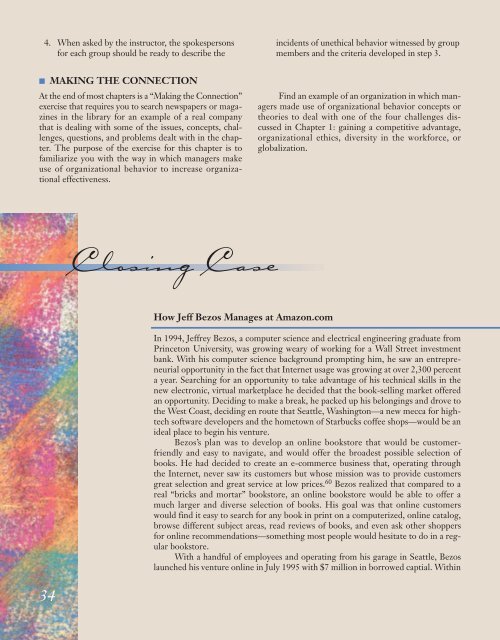chapter - Pearson
chapter - Pearson
chapter - Pearson
You also want an ePaper? Increase the reach of your titles
YUMPU automatically turns print PDFs into web optimized ePapers that Google loves.
4. When asked by the instructor, the spokespersons<br />
for each group should be ready to describe the<br />
incidents of unethical behavior witnessed by group<br />
members and the criteria developed in step 3.<br />
■ MAKING THE CONNECTION<br />
At the end of most <strong>chapter</strong>s is a “Making the Connection”<br />
exercise that requires you to search newspapers or magazines<br />
in the library for an example of a real company<br />
that is dealing with some of the issues, concepts, challenges,<br />
questions, and problems dealt with in the <strong>chapter</strong>.<br />
The purpose of the exercise for this <strong>chapter</strong> is to<br />
familiarize you with the way in which managers make<br />
use of organizational behavior to increase organizational<br />
effectiveness.<br />
Find an example of an organization in which managers<br />
made use of organizational behavior concepts or<br />
theories to deal with one of the four challenges discussed<br />
in Chapter 1: gaining a competitive advantage,<br />
organizational ethics, diversity in the workforce, or<br />
globalization.<br />
Closing Case<br />
How Jeff Bezos Manages at Amazon.com<br />
In 1994, Jeffrey Bezos, a computer science and electrical engineering graduate from<br />
Princeton University, was growing weary of working for a Wall Street investment<br />
bank. With his computer science background prompting him, he saw an entrepreneurial<br />
opportunity in the fact that Internet usage was growing at over 2,300 percent<br />
a year. Searching for an opportunity to take advantage of his technical skills in the<br />
new electronic, virtual marketplace he decided that the book-selling market offered<br />
an opportunity. Deciding to make a break, he packed up his belongings and drove to<br />
the West Coast, deciding en route that Seattle, Washington—a new mecca for hightech<br />
software developers and the hometown of Starbucks coffee shops—would be an<br />
ideal place to begin his venture.<br />
Bezos’s plan was to develop an online bookstore that would be customerfriendly<br />
and easy to navigate, and would offer the broadest possible selection of<br />
books. He had decided to create an e-commerce business that, operating through<br />
the Internet, never saw its customers but whose mission was to provide customers<br />
great selection and great service at low prices. 60 Bezos realized that compared to a<br />
real “bricks and mortar” bookstore, an online bookstore would be able to offer a<br />
much larger and diverse selection of books. His goal was that online customers<br />
would find it easy to search for any book in print on a computerized, online catalog,<br />
browse different subject areas, read reviews of books, and even ask other shoppers<br />
for online recommendations—something most people would hesitate to do in a regular<br />
bookstore.<br />
With a handful of employees and operating from his garage in Seattle, Bezos<br />
launched his venture online in July 1995 with $7 million in borrowed captial. Within<br />
34

















